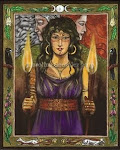Sunday, May 11, 2014
The Nine Muses, Goddesses of Inspiration
The Muses in Greek mythology consisted of nine goddesses that were known to give inspiration to those partaking in creative endeavors. They were known to rule over music, dance, poetry, artistry, science, mathematics, astronomy and drama. The Muses are daughters of Zeus, Father of the Gods, and Mnemosyne, Goddess of memory. In Greek myth it is said that Zeus laid with Mnemosyne for nine nights and a year later she gave birth to nine daughters who were known for their creative talents and gift of song.
In myth the Muses were sometimes referred to as water nymphs as they were associated with four sacred springs. The Muses were said not to care about human affairs but were immersed in all ways of creativity. Their main cult center was located at Mount Helicon in Boeotia, Greece. A festival was celebrated in their honor every four years at Thespiae (near Helicon) in which much singing and dancing took place.
The Muses gave inspiration to many poets and philosophers. They were said to usually be invoked prior to any kind of creative activity. It is said that the Muses inspired Hesiod to write his epic poem the Theogony.
Below is a list of each of the Muses along with their correspondences.
Kleio - Muse of history. Her name in Greek means "to celebrate" or "famous". She is often depicted carrying a scroll or sitting next to a chest of books
Kalliope - Muse of epic poetry. Her name in Greek means "beautiful-voiced". She was said to also be a Goddess of eloquence and wisdom. Kalliope was depicted carrying a writing tablet or a book.
Erato - Muse of lyric poetry especially known for her love and erotic poetry. Her name means "lovely" or "beloved". She is depicted wearing a wreath made from myrtle and roses and holding a lyre.
Euterpe - Muse of music. She was the Goddess that performed for the Gods on Mount Olympus. Her name means "the giver of much delight" and she is depicted playing or often holding a flute.
Melpomene - Muse of tragedy or drama. Her name means "to celebrate with dance and song". She is depicted wearing a tragic mask and wearing the boots that those types of actors wore.
Polyhymnia - Muse of sacred poetry and sacred hymn. Her name can mean "praise" or "hymn". She is depicted as being in very serious thought while holding a finger to her mouth.
Terpsikhore - Muse of dance. Her name means "delight in dancing". She is depicted sitting or standing while holding a lyre.
Thalia - Muse of comedy and idyllic poetry. Her name means "rich festivity" or "blooming". She is depicted wearing a crown of ivy and wearing a comic mask.
Urania - Muse of astronomy. Her name means "heavenly" or "of heaven". Urania can tell the future by the arrangement of the stars. She is depicted wearing a cloak embroidered with the stars while pointing to a celestial globe.
Artist ~ Andrea Mantegna - Parnassus
Subscribe to:
Post Comments (Atom)




No comments:
Post a Comment
Thank you so much for your comment! I appreciate your support! Many blessings to you )O(